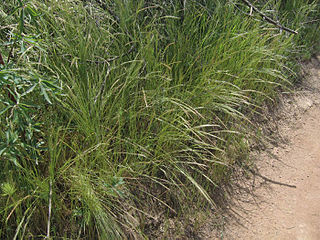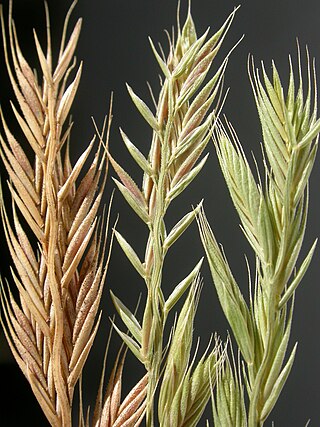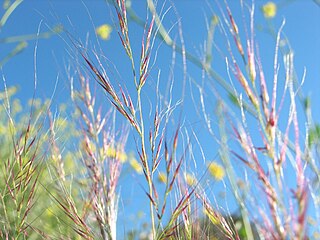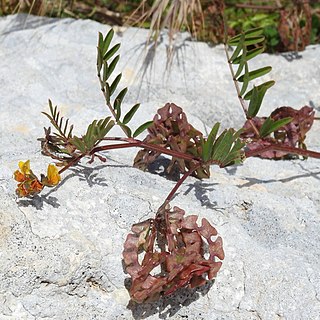
Festuca (fescue) is a genus of flowering plants belonging to the grass family Poaceae. They are evergreen or herbaceous perennial tufted grasses with a height range of 10–200 cm (4–79 in) and a cosmopolitan distribution, occurring on every continent except Antarctica. The genus is closely related to ryegrass (Lolium), and recent evidence from phylogenetic studies using DNA sequencing of plant mitochondrial DNA shows that the genus lacks monophyly. As a result, plant taxonomists have moved several species, including the forage grasses tall fescue and meadow fescue, from the genus Festuca into the genus Lolium, or alternatively into the segregate genus Schedonorus.

Vulpia myuros, the annual fescue, or rat's-tail fescue, is an annual flowering plant in grass family Poaceae. It was probably originally native to Eurasia, but it can now be found nearly worldwide as a naturalized species.

Vulpia is a widespread genus of plants in the grass family, native to many countries around the world and naturalized in many of the nations to which it is not native. It is most common in temperate regions.

Vulpia bromoides, squirreltail fescue, barren fescue or brome fescue, is a species of grass in the family Poaceae. It is a winter annual native to Europe, North Africa, and West Asia, but has been introduced to parts of the America, South Africa, Australia, New Zealand and isolated parts of East Asia.

Vulpia microstachys is a species of grass known by the common names small fescue and small sixweeks grass. It is native to western North America from British Columbia to Colorado and New Mexico to Baja California, where it grows in many types of open habitat, including grasslands. It is dominant on some grasslands of California, and it was probably an abundant native grass before the habitat was altered by invasive non-native grasses. It occurs on serpentine soils with associates such as serpentine reedgrass. It is also known from parts of South America. It is an annual grass producing one stem or a clump of several stems growing up to 75 centimeters tall. The inflorescence has several open branches bearing clusters of purple-tinged spikelets. The spikelet has one to six flowers. The grass is usually cleistogamous, its flowers fertilizing themselves.

Festuca octoflora, also known as Vulpia octoflora, is an annual plant in the grass family (Poaceae). The common name six-week fescue is because it supplies about 6 weeks of cattle forage after a rain. Other common names include sixweeks fescue, six-weeks fescue, pullout grass, eight-flower six-weeks grass, or eight-flowered fescue.
Vulpia elliotea, known by the common name sand fescue or squirreltail fescue, is an annual grass native to the southeastern United States. Its specific epithet elliotea is named for its discoverer, Stephen Elliott.
Bromus fasciculatus is a species of herb in the family Poaceae.

Centaurium tenuiflorum, the slender centaury, is a species of annual herb in the family Gentianaceae. They have a self-supporting growth form and simple, broad leaves. Individuals can grow to 17 cm tall.
Eleocharis ovata, the ovate spikerush, is a species of annual grass in the family Cyperaceae (sedges). They have a self-supporting growth form and have simple, broad leaves and green flowers. Individuals can grow to 1.5 feet.

Festuca cinerea, the blue fescue, is a species of perennial grass in the family Poaceae. They have a self-supporting growth form and simple, broad leaves. Individuals can grow to 29 cm tall.

Hippocrepis multisiliquosa is a species of annual herb in the family Fabaceae. They have a self-supporting growth form and compound, broad leaves. Individuals can grow to 24 cm tall.

Hypecoum procumbens, the sickle-fruited hypecoum, is a species of annual herb in the family Papaveraceae. They have a self-supporting growth form and simple leaves. Individuals can grow to 40 cm tall.
Hypericum australe is a species of plant in the family Hypericaceae. Individuals can grow to 24 cm tall.

Misopates calycinum is a species of annual herb in the family Plantaginaceae. They have simple leaves.

Vulpia ciliata is a species of plant in the family Poaceae.

Scorzonera laciniata, also known as cutleaf vipergrass, is a species of herb in the family Asteraceae.

Tamarix africana, the African tamarisk, is a species of tree in the family Tamaricaceae. They have a self-supporting growth form and simple leaves. Individuals can grow to 6.3 m.

Trifolium lappaceum, the burdock clover, is a species of annual herb in the family Fabaceae. They have a self-supporting growth form and compound, broad leaves.

Trifolium suffocatum, the suffocated clover, is a species of annual herb in the family Fabaceae. They have a self-supporting growth form and compound, broad leaves. Individuals can grow to 4.2 cm.















